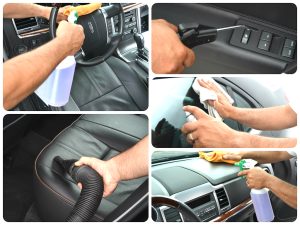Vehicle detailing is an activity which maintains the vehicle’s quality at all times, especially during regular maintenance. As opposed to mechanical detailing, this mainly deals with cosmetic improvements, such as changing or repairing small dents and scratches. As a matter of fact, car detailing comprises cleaning and refurbishing the interiors of a vehicle. Some car detailers focus their efforts on the exteriors of a vehicle while other concentrate on its exteriors only. However, when it comes to the detailing of vans, the task seems to be more daunting since it is subjected to much more scrutiny and rigorous techniques. And since it is a large vehicle, the process becomes even more demanding since more work and time is dedicated to it.
 car detailing services can also deal with the cleaning of interiors. The term “exterior” refers to all the non-removable items that are attached to a vehicle, such as seats, dashboard trims, door handles, head lamps, arm rests, etc. These things are usually not removable and provide valuable service as guides for the visual inspection of the vehicle. Some of the areas which need to be cleaned are the glove box, engine compartment, boot floor, rear window, side windows and license plate frames. Some of the detailing services also involve the cleaning of the tail lights and bumpers.
car detailing services can also deal with the cleaning of interiors. The term “exterior” refers to all the non-removable items that are attached to a vehicle, such as seats, dashboard trims, door handles, head lamps, arm rests, etc. These things are usually not removable and provide valuable service as guides for the visual inspection of the vehicle. Some of the areas which need to be cleaned are the glove box, engine compartment, boot floor, rear window, side windows and license plate frames. Some of the detailing services also involve the cleaning of the tail lights and bumpers.
Another important aspect in car detailing is waxing. Waxing, however, is generally performed on the non-moving parts such as the seats, door trim, windows, trunk and so on. In order to clean interior surfaces, the wax has to be removed. Most vehicle owners prefer to remove the interior wax by hand to minimize the risks of accidents such as getting trapped in the wax, or getting the sealant too wet and therefore becoming useless. Professionals apply the wax in a machine and then watch it as it cools off.
Detailing involves removal of debris and loose objects in and around the vehicle. Some of the common debris which needs to be removed include bugs, bird poop, grime, mud and water beads. Dirt particles and mud can cause damage to the internal parts of the engine which makes it very difficult to start. Some of the other common things which need to be removed during detailing include tar, grease, polish, oil and other fluid. After removing these things, the interior of the vehicle is cleaned of debris and any signs of damage. The tire is then inspected for cracks, sharp edges and other damage.
For engine detailing, special attention is paid to the transmission, brakes, clutch, brakes and other drive train components. Sometimes, these things get stuck in between the pedals. Special pumps are used to remove them from the interior surfaces and they are then removed by hand using a brush. Any physical damage to these parts must be replaced immediately and they must be protected from further wear and tear.
Detailing experts use detailing products which are eco-friendly and do not contain harsh chemicals. For instance, car wash products used in the city are usually chlorinated, and some manufacturers require that they be sold in trace amounts to avoid endangering the community with the danger of environmental pollution. Using an eco-friendly product is the best way to ensure that these hazardous chemicals are not used. Many people have enjoyed the benefits of taking a vacation or going on an RV detailing trip due to the fact that they have managed to keep their personal cars and rv’s free of any type of damage. The rv detailing process has become increasingly popular and more people are enjoying the benefits of this unique hobby.